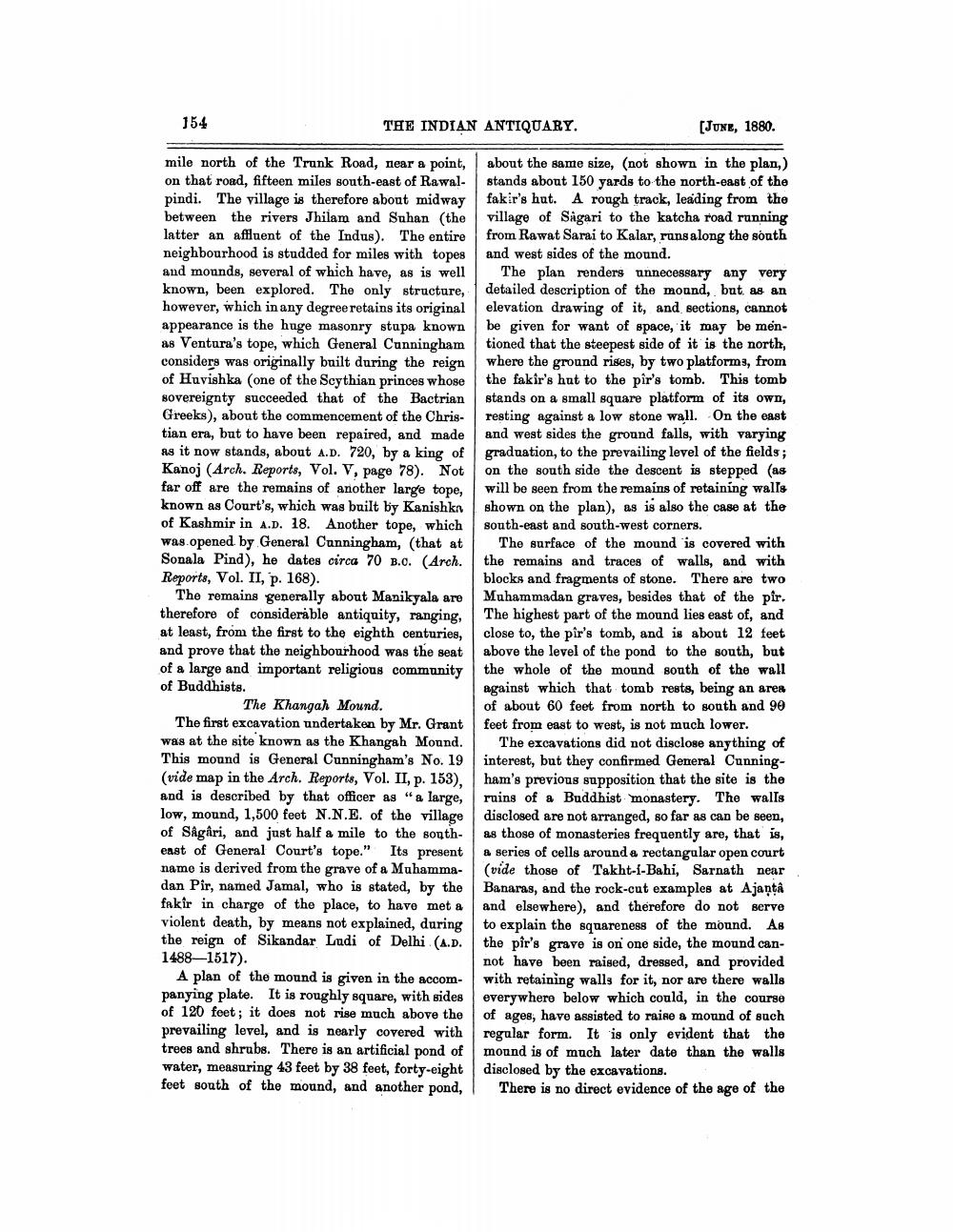________________
154
THE INDIAN ANTIQUARY.
[JUNE, 1880.
mile north of the Trunk Road, near a point, on that road, fifteen miles south-east of Rawal- pindi. The village is therefore about midway between the rivers Jhilam and Suhan (the latter an affluent of the Indus). The entire neighbourhood is studded for miles with topes and mounds, several of which have, as is well known, been explored. The only structure, however, which in any degree retains its original appearance is the huge masonry stupa known as Ventura's tope, which General Cunningham considers was originally built during the reign of Huvishka (one of the Scythian princes whose sovereignty succeeded that of the Bactrian Greeks), about the commencement of the Christian era, but to have been repaired, and made As it now stands, about A.D. 720, by a king of Kanoj (Arch. Reports, Vol. V, page 78). Not far off are the remains of another large tope, known as Court's, which was built by Kanishkn of Kashmir in A.D. 18. Another tope, which was opened by General Cunningham, (that at Sonala Pind), he dates circa 70 B.C. (Arch. Reports, Vol. II, p. 168).
The remains generally about Manikyala are therefore of considerable antiquity, ranging, at least, from the first to the eighth centuries, and prove that the neighbourhood was the seat of a large and important religious community of Buddhists.
The Khangah Mound. The first excavation undertaken by Mr. Grant was at the site known as the Khangah Mound. This mound is General Cunningham's No. 19 (vide map in the Arch. Reports, Vol. II, p. 153). and is described by that officer as "a large, low, mound, 1,500 feet N.N.E. of the village of Sagari, and just half a mile to the southeast of General Court's tope." Its present name is derived from the grave of a Muhammadan Pir, named Jamal, who is stated, by the fakir in charge of the place, to have met a violent death, by means not explained, during the reign of Sikandar Ludi of Delhi (A.D. 1488—1517).
A plan of the mound is given in the accompanying plate. It is roughly square, with sides of 120 feet; it does not rise much above the prevailing level, and is nearly covered with trees and shrubs. There is an artificial pond of water, measuring 43 feet by 38 feet, forty-eight feet south of the mound, and another pond,
about the same size, (not shown in the plan,) stands about 150 yards to the north-east of the fakir's hut. A rough track, leading from the village of Sågari to the katcha road running from Rawat Sarai to Kalar, runs along the south and west sides of the mound.
The plan renders unnecessary any very detailed description of the mound, but as an elevation drawing of it, and sections, cannot be given for want of space, it may be mentioned that the steepest side of it is the north, where the ground rises, by two platforms, from the fakir's hut to the pîr's tomb. This tomb stands on a small square platform of its own, resting against a low stone wall. On the east and west sides the ground falls, with varying graduation, to the prevailing level of the fields; on the south side the descent is stepped (as will be seen from the remains of retaining walls shown on the plan), as is also the case at the south-east and south-west corners.
The surface of the mound is covered with the remains and traces of walls, and with blocks and fragments of stone. There are two Muhammadan graves, besides that of the pir.
The highest part of the mound lies east of, and close to, the pîr's tomb, and is about 12 feet above the level of the pond to the south, but the whole of the mound south of the wall against which that tomb rests, being an area of about 60 feet from north to south and 90 feet from east to west, is not much lower.
The excavations did not disclose anything of interest, but they confirmed General Cunningham's previous supposition that the site is the ruins of a Buddhist monastery. The walls disclosed are not arranged, so far as can be seen, as those of monasteries frequently are, that is, a series of cells around a rectangular open court (vide those of Takht-i-Bahi, Sarnath near Banaras, and the rock-cut examples at Ajantâ and elsewhere), and therefore do not serve to explain the squareness of the mound. As the pir's grave is on one side, the mound cannot have been raised, dressed, and provided with retaining walls for it, nor are there walls everywhere below which could, in the course of ages, have assisted to raise a mound of such regular form. It is only evident that the mound is of much later date than the walls disclosed by the excavations.
There is no direct evidence of the age of the




